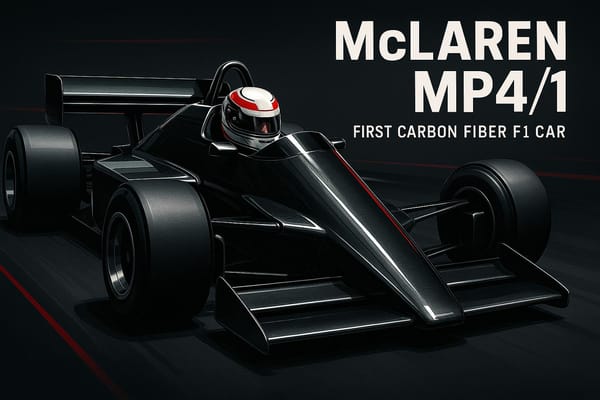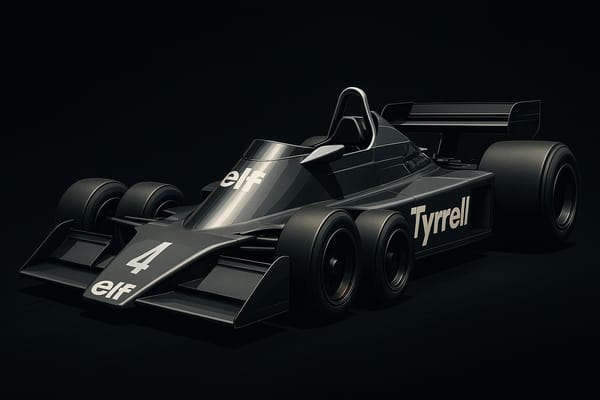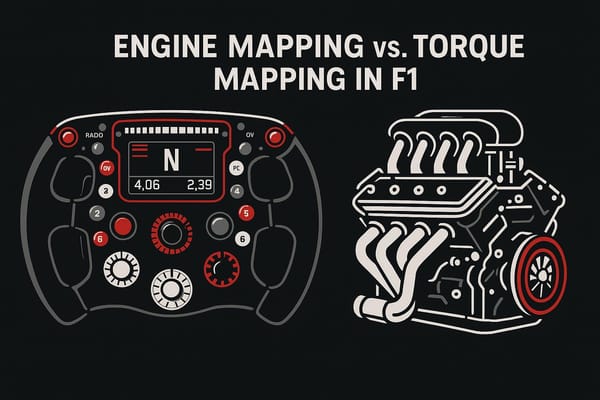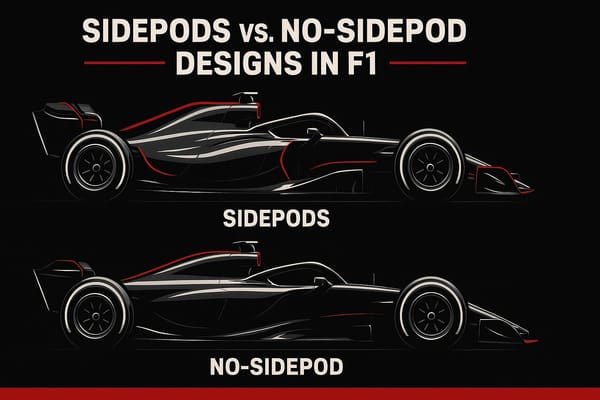Desert Duel: Strategy Preview for the 2025 Bahrain Grand Prix
Explore the strategies and challenges teams face at the 2025 Bahrain Grand Prix, including tire management and fuel efficiency in extreme conditions.
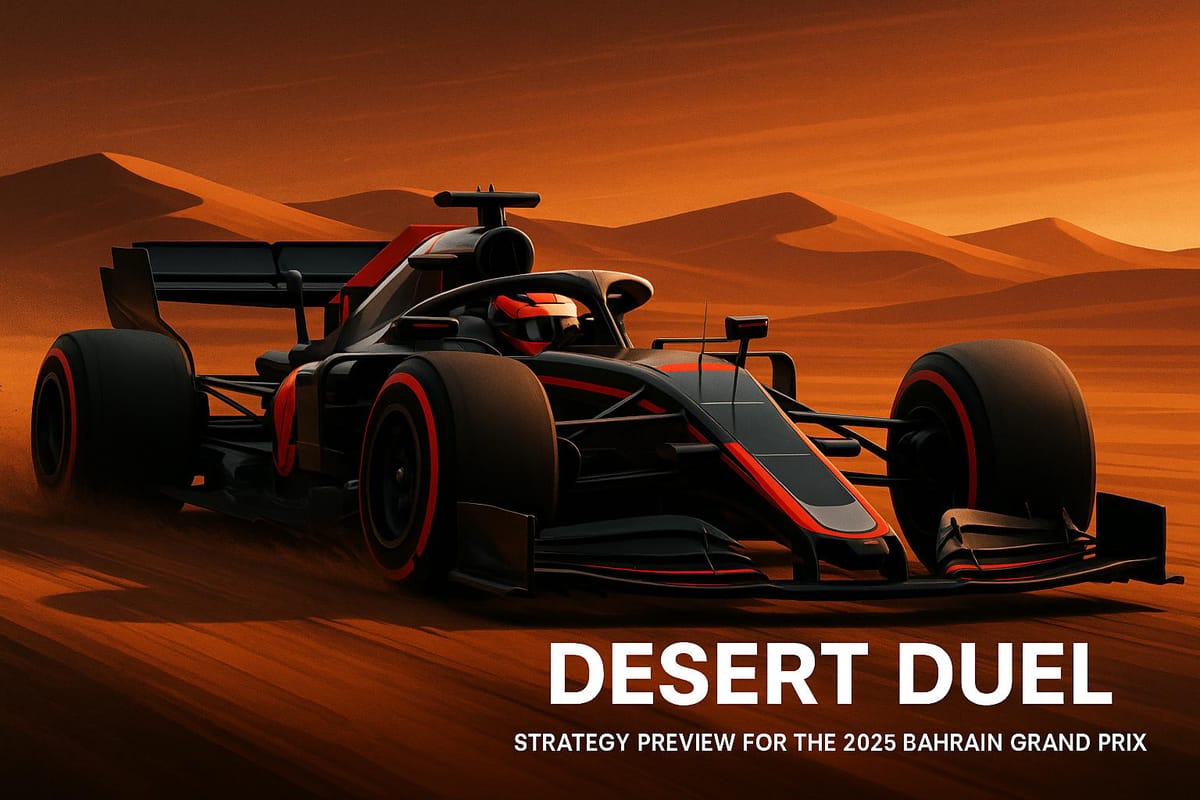
The Bahrain Grand Prix is a battle of precision and endurance. Here's what you need to know:
- The Bahrain International Circuit is brutal on tires, thanks to its abrasive surface and desert winds. Expect higher degradation and likely two-stop strategies.
- Night racing brings temperature shifts, requiring teams to adjust setups constantly.
- Key overtaking zones include Turns 1, 4, 10, and the exit of Turns 14–15.
Team Highlights:
- Red Bull: Focused on fine-tuning their car for heat and tire wear, with a soft-hard-soft tire strategy in mind.
- McLaren: Leveraging advanced brake cooling tech and aiming for consistency with a double-medium tire plan.
- Mercedes: Balancing high-downforce setups to reduce rear tire wear but sacrificing some straight-line speed.
- Ferrari: Banking on high-downforce configurations and efficient fuel use to stay competitive.
With pit stops costing around 24 seconds and a 63% chance of a Safety Car, timing and strategy will be critical. McLaren's strong start to the season positions them as a favorite, while Red Bull faces challenges in low-speed corners. Ferrari and Mercedes remain competitive but need flawless execution to contend.
F1 Bahrain GP: Ferrari SF-25 very competitive with Mediums, Charles Leclerc penalized by Safety Car
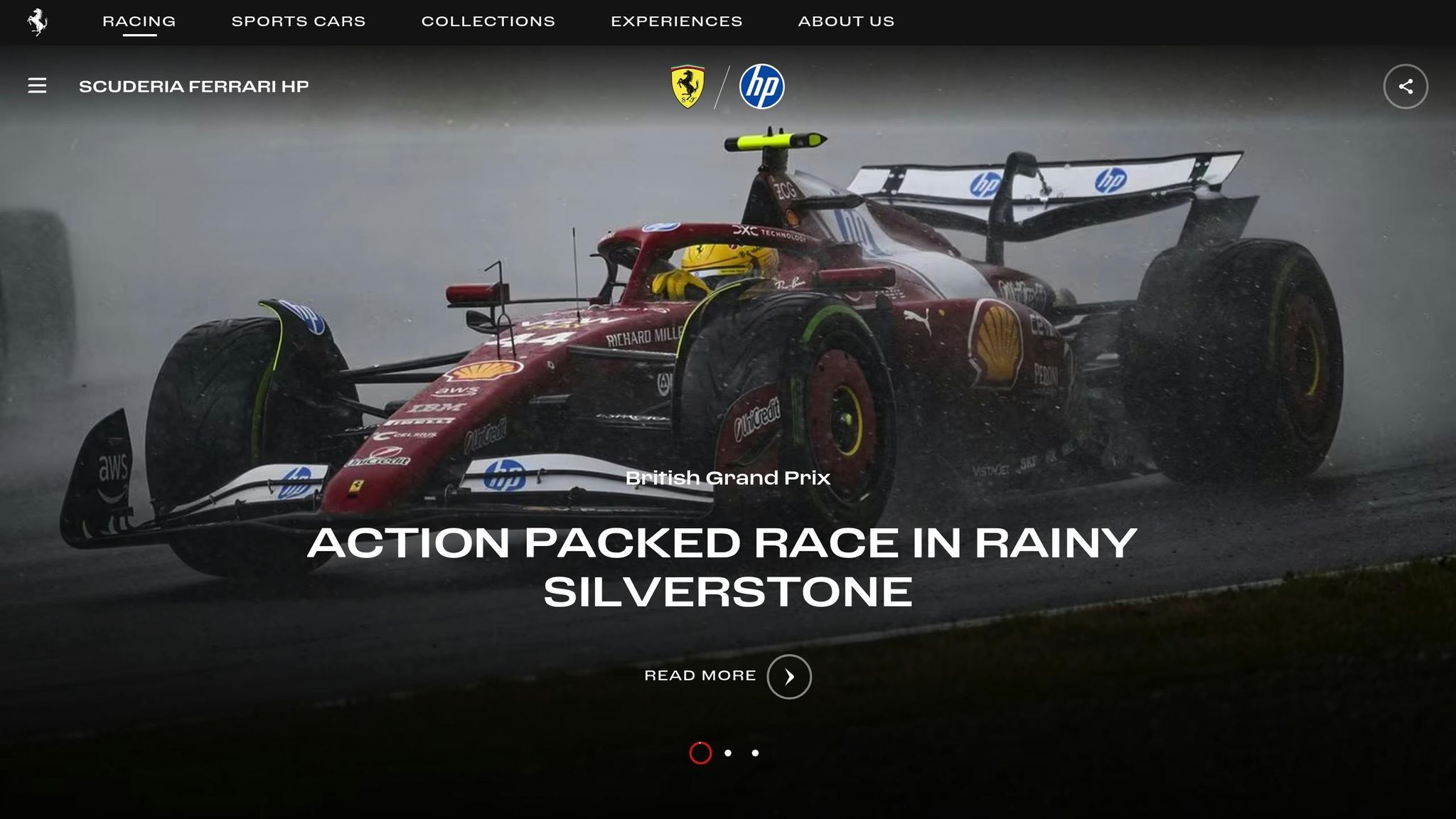
1. Red Bull Racing
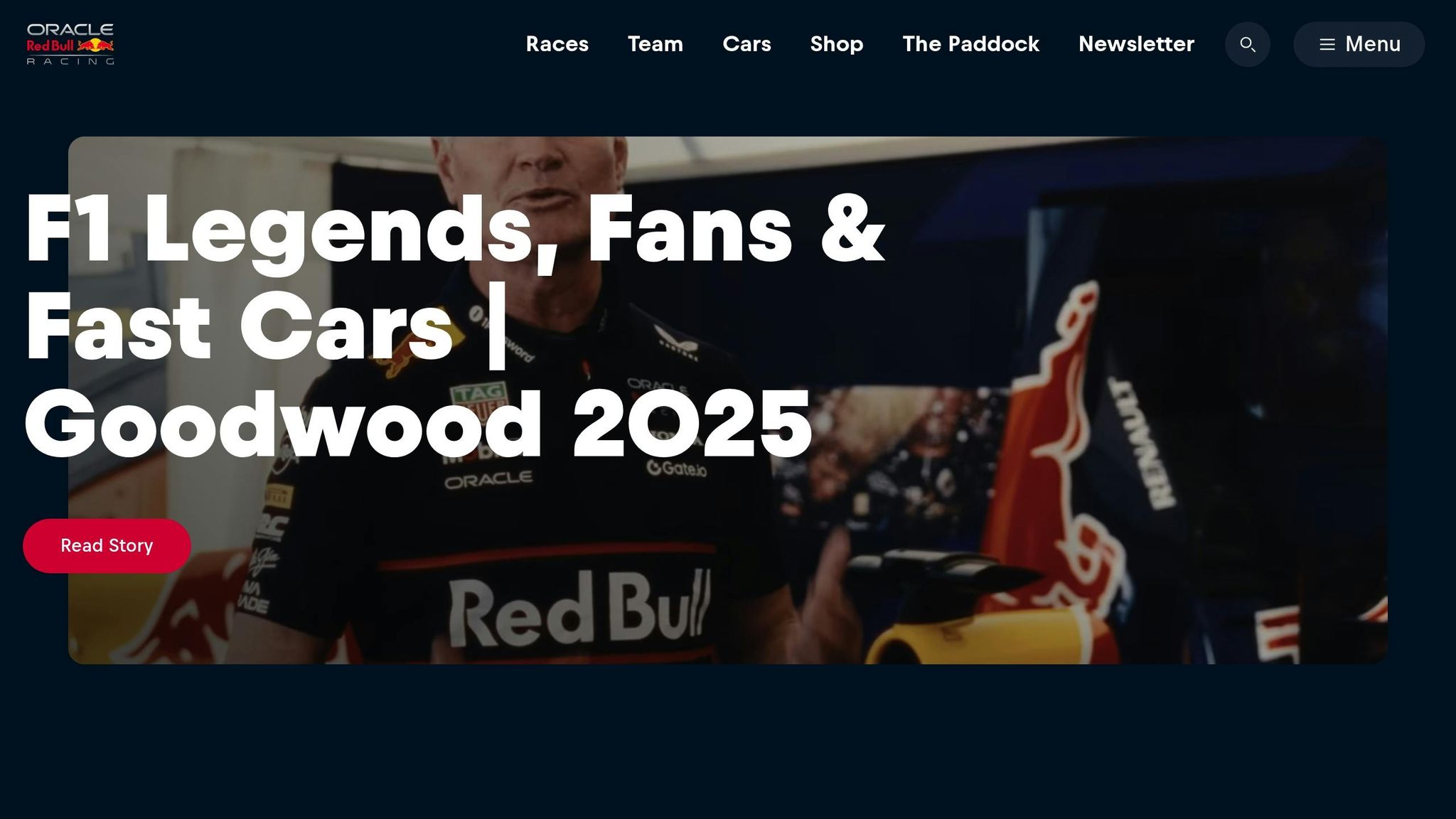
Red Bull Racing heads into the Bahrain Grand Prix with a solid game plan, leveraging the extensive pre-season data they collected at the Sakhir circuit. Their focus? To fine-tune their car’s performance for the unique challenges of Bahrain’s abrasive track surface and scorching temperatures.
Tire Management
Tire strategy is a critical piece of Red Bull's approach, especially with Pirelli introducing softer tire compounds for 2025. The C2 (medium) and C3 (soft) compounds are softer than last year’s versions, which means teams face both opportunities and hurdles when it comes to managing tire wear on this demanding circuit.
"Temperature will be a very important variable when it comes to tyre management at the fourth race of the year. However, this weekend's temperatures will present a new challenge, because during the test week, Sakhir saw unusual weather with strong winds leading to much cooler air and track temperatures than is normal at that time of year." - Pirelli
During testing, Red Bull dealt with cooler, windier conditions than what’s expected for race day, forcing them to prepare for a much hotter environment. This means fine-tuning their setup to handle the increased heat.
Max Verstappen has been given two fresh sets of hard tires, offering the team some extra flexibility. Pairing this with strategic fuel adjustments (more on that below) will be key to managing performance over the race’s 57 laps.
Fuel Strategy
Red Bull’s fuel strategy is likely to include running with a reduced fuel load - somewhere between 5–15 kg lighter. This approach not only improves lap times but also eases the strain on tires, which is especially useful on a track like Bahrain.
"In F1 we're formulating a fuel to work with that specific engine, optimising the performance to the last degree." - David Tsurusaki, ExxonMobil's global motorsports technology manager
However, lighter fuel loads come with a trade-off: the potential need for an extra pit stop. With pit stops costing around 24 seconds in Bahrain, Red Bull will need to carefully weigh the benefits of speed against the time lost in the pits. They’ll likely refine their soft–hard–soft tire strategy from last year to strike the perfect balance.
Overtaking Opportunities
Key overtaking zones - Turns 1, 4, 11, and the final corner complex - will be the focus for Red Bull drivers. Their aerodynamic strengths should give them the straight-line speed needed to excel in these high-stakes braking zones. Bahrain’s wide track layout also allows for creative moves, including three-wide racing and alternative lines. The undercut strategy, which has proven effective here in past races, remains a valuable tool in their playbook.
Weather Response
Red Bull’s ability to adapt to changing temperatures will be crucial as the weekend progresses from qualifying to race day. Their engineers will rely on simulation data and real-time analysis to tweak aerodynamic settings and tire pressures as conditions shift. With the softer 2025 compounds in play, the team is prepared to make quick adjustments to stay competitive in the evolving environment.
2. McLaren
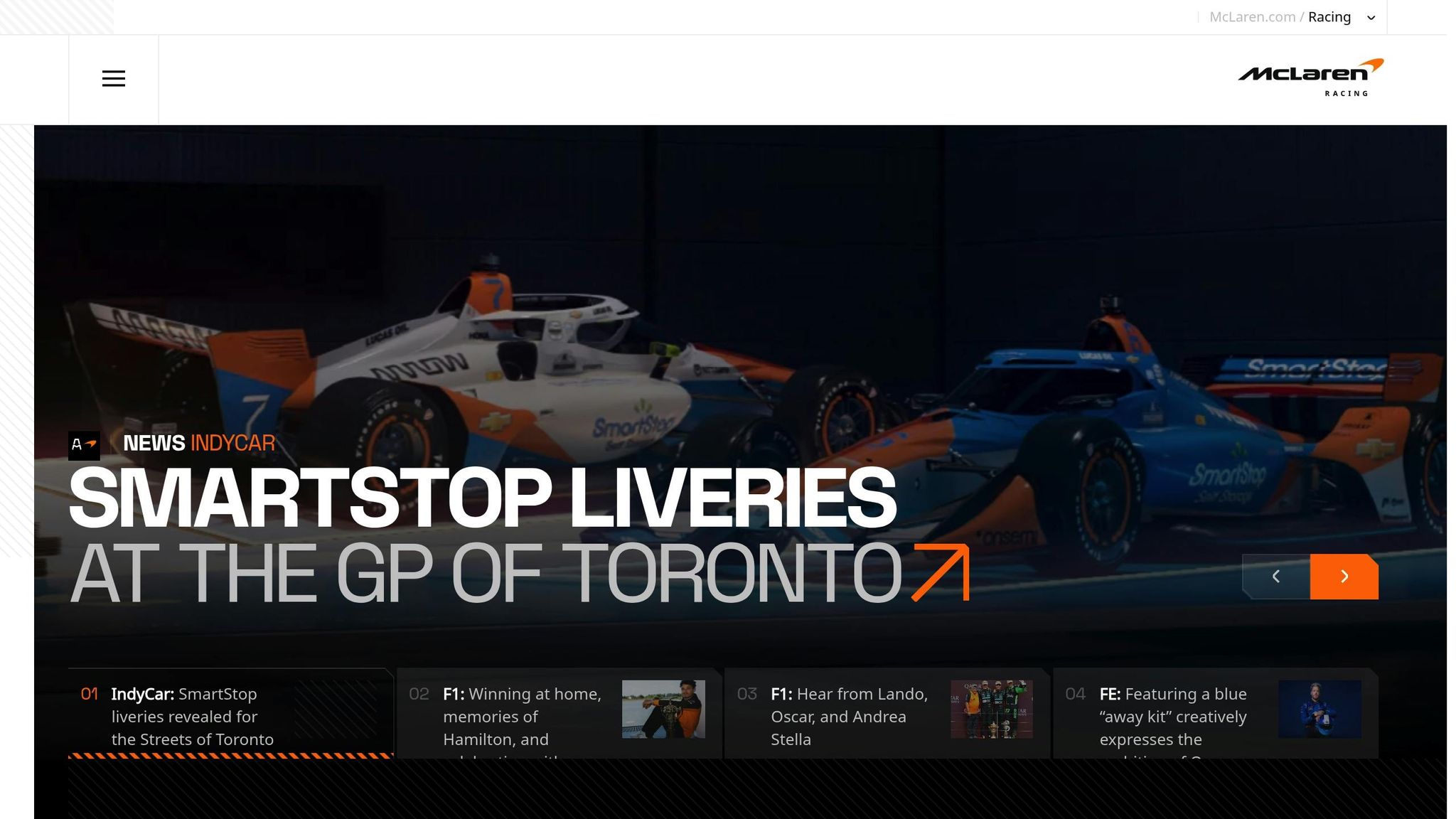
After an impressive season opener with Piastri securing a win and Norris finishing third, McLaren is looking to carry that momentum into Bahrain. Unlike other teams, McLaren leans on technical ingenuity to tackle the unique challenges posed by Bahrain's desert climate.
Tire Management
McLaren has introduced a cutting-edge brake drum cooling system to address the high tire degradation that comes with Bahrain's demanding circuit. The MCL39 features specially designed brake drums that regulate tire temperatures using adaptive airflow. These drums include bimetallic plates that adjust their position based on heat levels, preventing tires from overheating and wearing out too quickly. This innovation has been key to their decision to adopt a double-medium tire strategy.
During the 2025 race, this strategy paid off as Piastri maintained consistent lap times of 1:35–1:36 during his final stint. His performance dropped by only 1.4 seconds, a significant improvement over the 2.4-second drop typically seen with softer tires. As Piastri himself remarked, "the medium was 'the one to be on' in the final stint". The C2 medium compound proved its reliability, accounting for 46% of all race laps.
Fuel Strategy
McLaren's fuel strategy is designed to maximize efficiency, extending stints and reducing the need for pit stops. The team fine-tunes fuel load calculations to adapt to the desert's unpredictable conditions, such as 180-degree wind shifts that blow sand onto the track. This meticulous planning allows McLaren to maintain a steady pace throughout the race and seize overtaking opportunities when they arise.
Overtaking Opportunities
With optimized tire performance and fewer pit stops, McLaren's drivers are well-positioned to take advantage of Bahrain International Circuit's overtaking zones. The track is known for its multiple passing opportunities, highlighted by the 66 overtakes recorded during the 2024 race. Key zones include the end of the main straight leading into Turn 1 and Turn 4, which follows the second DRS zone.
Weather Response
As Bahrain's race transitions from day to night, temperature fluctuations demand quick adjustments. McLaren's advanced thermal management system, particularly the brake drum cooling technology, ensures their tires remain effective despite the changing conditions.
3. Mercedes
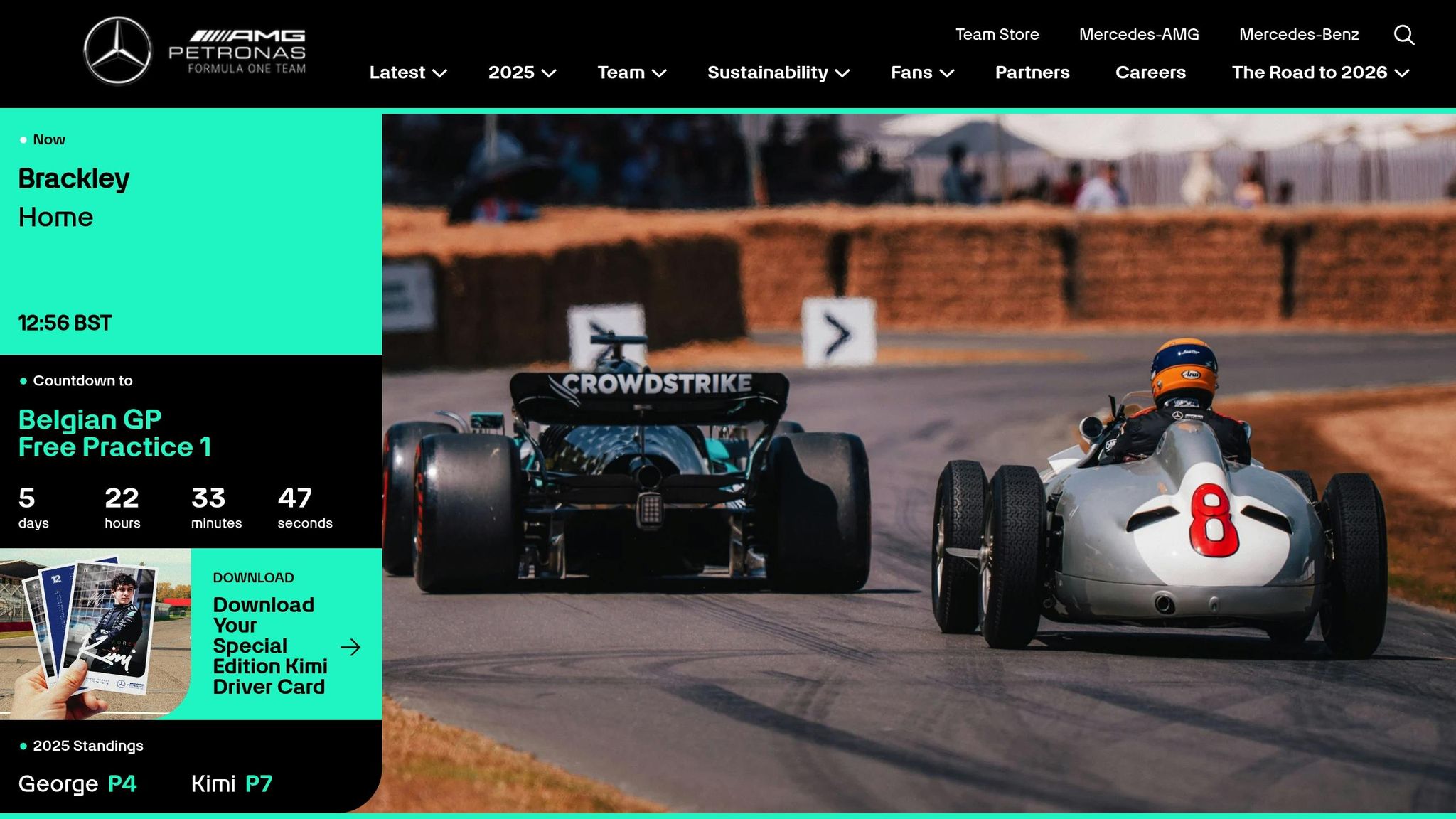
Mercedes heads back to Bahrain, focusing on refining their strategies for tire management and fuel efficiency. With the W16, they aim to push the car's limits at the same track where pre-season testing took place, fine-tuning their approach to tackle the desert's unique challenges.
Tire Management
To handle Bahrain's abrasive track surface, Mercedes has opted for a high-downforce setup. This configuration minimizes rear tire sliding, which helps combat wear, though it comes at the cost of straight-line speed. The scorching track temperatures, especially during the latter stages of the race, could further accelerate rear tire degradation.
For 2025, updated tire regulations introduce higher minimum starting pressures - 23 psi for the front and 21 psi for the rear. Compared to 2024, this is an increase of 1 psi on the front and 2 psi on the rear. These changes, combined with an improved compound spread, open up new strategic options. The C2 tire could now play a more prominent role, making one-stop strategies a viable possibility.
"Small things which can cost you a few hundredths in the qualifying can be a bit of a benefit with tire life in the race", - Valtteri Bottas
Fuel Strategy
Bahrain's 5.412 km circuit demands a careful balance of fuel load and performance. The mix of long straights and varying corner speeds challenges drivers to maintain rhythm, while also testing the team's fuel calculations.
As the race progresses and ambient temperatures drop from around 82°F (28°C), Mercedes engineers adjust fuel loads to adapt to changes in aerodynamic efficiency and cooling needs. By fine-tuning these calculations, they aim to avoid excessive fuel conservation while optimizing performance for overtaking opportunities.
Overtaking Opportunities
In the 2025 race, George Russell secured second place and clocked the fastest lap [20, 24]. Mercedes’ strategy emphasizes capitalizing on key overtaking zones, particularly at the end of the main straight leading into Turn 1. Kimi Antonelli demonstrated the car's overtaking potential with several standout moves, though strategic decisions ultimately limited him to an 11th-place finish [20, 24].
Weather Response
Bahrain's unpredictable wind patterns are a key factor in Mercedes' desert strategy. Their high-downforce setup provides added stability, helping drivers manage sudden wind shifts and reducing the risk of oversteer in less aerodynamically supported areas.
"Tyre management and a good balance in the car is really important for a good race in Sakhir", - Fred Vesti, Test and Reserve Driver, Mercedes-AMG PETRONAS F1 Team
As temperatures drop during the race, cooling efficiency becomes critical. Mercedes engineers keep a close eye on thermal degradation, knowing that consistent tire performance in changing conditions is essential for success in the final stints. This adaptability to weather fluctuations is a key component of their overall race strategy.
4. Ferrari
Ferrari introduces its SF-25 update in Bahrain, showcasing a redesigned floor aimed at increasing downforce and minimizing airflow losses. The team faces the dual challenge of mastering Bahrain's blend of high-speed straights and technical corners while also contending with the intense desert heat.
Tire Management
Ferrari's tire management plan is focused on handling Bahrain's abrasive surface and high temperatures, which accelerate rear tire wear. As the race transitions from the heat of the day to cooler evening conditions, managing tire temperatures becomes critical. The team heads into the weekend with two fresh sets of Medium tires, matching the allocation of McLaren, Aston Martin, and Sauber. Pirelli has supplied C1 (Hard), C2 (Medium), and C3 (Soft) compounds for the 2025 race.
To extend tire life, Ferrari's engineers are working on improving mechanical grip in low and medium-speed corners, where traction plays a big role. Additionally, new minimum tire pressure requirements - 23.0 psi at the front and 21.0 psi at the rear - add another layer of complexity. With Pirelli's slightly softer C2 and C3 compounds for 2025, Ferrari may opt for more aggressive setups to maximize performance. These efforts tie directly into the team's precise fuel calculations, ensuring efficient energy use over the race.
Fuel Strategy
Charles Leclerc's speed trap reading of 327.3 km/h during qualifying highlights the SF-25's straight-line power. Ferrari's fuel strategy must account for Bahrain's long acceleration zones and heavy braking areas. Starting the race on Medium tires shows the team’s confidence in managing tire degradation over extended stints. This choice requires meticulous fuel calculations to maintain a competitive pace throughout the race.
Leclerc's push for a one-stop strategy further emphasizes Ferrari's belief in its efficiency. The updated floor design, which reduces airflow losses, also enhances aerodynamic efficiency. By carefully managing fuel, Ferrari ensures consistent speed while setting up key overtaking opportunities during the race.
Overtaking Opportunities
Ferrari's straight-line speed advantage gives the team a strong chance to capitalize on Bahrain's overtaking zones. The main opportunities are at Turn 1 and Turn 4, where the two DRS zones end.
"Overtaking opportunities are clear here: into Turn 1 and Turn 4, where the two DRS zones end." – Jolyon Palmer, former Renault F1 driver
The 353-meter run to Turn 1 is particularly favorable for Ferrari to exploit its top speed. With 66 overtakes recorded during the 2024 Bahrain Grand Prix, the circuit's layout encourages bold moves. Despite the impact of strategic decisions and safety car interventions, Ferrari's pace in the 2025 race highlighted its ability to take advantage of these opportunities, especially as cooler track conditions emerged later in the race.
Weather Response
With a 63% chance of a Safety Car and a 50% probability of a Virtual Safety Car at Bahrain, Ferrari must stay flexible. The team has upgraded its cooling systems to handle the desert heat and prevent sand from affecting performance. As track temperatures drop from day to night, Ferrari's aerodynamic package must adapt to the changing conditions.
Given the high cost of pit stops, timing is everything. Ferrari's weather response strategy combines real-time aerodynamic tweaks with careful tire pressure management to maintain peak performance as conditions shift. This integrated approach across tires, fuel, and aerodynamics positions Ferrari to adapt effectively to Bahrain's unpredictable race dynamics.
Strengths and Weaknesses
Bahrain's desert presents a tough challenge for teams, with its abrasive track surface, unpredictable temperatures, and shifting winds. These conditions test tire management and aerodynamic performance, exposing both strengths and vulnerabilities.
Red Bull stands out for its aerodynamic efficiency, which gives them an advantage in technical sections. However, their limited tire allocation - just one fresh set of medium tires - could hinder their race strategy. Their emphasis on downforce helps manage rear tire wear, a crucial factor on Bahrain's demanding surface.
McLaren takes a different approach with a simpler front wing design that boosts top speed, making them competitive in DRS zones. With two fresh medium tire sets available, they have more flexibility in strategy. However, this setup sacrifices some downforce, leaving them less effective in slower, technical corners.
Mercedes opts for a balanced aerodynamic setup that prioritizes drag reduction. But like Red Bull, they only have one fresh medium tire set, which limits their options.
Ferrari leans into a high-downforce configuration, excelling in technical sections. With two fresh medium tire sets, they enjoy greater strategic flexibility. Still, there are lingering concerns about how their overall package will hold up during the race.
Here’s a quick breakdown of each team's strengths, weaknesses, and tire allocations:
| Team | Key Strengths | Primary Weaknesses | Tire Allocation |
|---|---|---|---|
| Red Bull | Strong downforce | Limited tire allocation | 1 fresh medium set |
| McLaren | High top speed, strategic flexibility | Reduced downforce in technical corners | 2 fresh medium sets |
| Mercedes | Balanced aerodynamics | Restricted tire strategy | 1 fresh medium set |
| Ferrari | High downforce, versatile strategy | Uncertain overall performance | 2 fresh medium sets |
The extreme temperature swings in Bahrain add another layer of complexity. Ambient temperatures can rise over 36°F higher than those seen during pre-season testing, which accelerates tire degradation - particularly at the rear - due to Bahrain's heavy acceleration zones. Managing these temperature shifts will be critical throughout the weekend.
Wind conditions also play a significant role, with directions capable of shifting up to 180 degrees during the race. These changes can disrupt aerodynamic balance, but teams with higher downforce setups may handle them better. Additionally, Bahrain's abrasive surface makes the undercut strategy particularly effective, adding another tactical element to consider.
Braking performance is another key factor. According to Brembo, brakes are active for 18% of each lap and are rated 4 out of 5 in terms of difficulty. This forces teams to carefully balance cooling requirements with aerodynamic efficiency to maintain performance in Bahrain's demanding environment.
Conclusion
The 2025 Bahrain Grand Prix is shaping up to be a critical test, and McLaren seems to have the upper hand on this notoriously abrasive circuit. Earlier this season, Oscar Piastri's victory showcased McLaren's knack for managing tire temperatures - a skill that will be essential on Bahrain's demanding track conditions.
This advantage becomes even more apparent when compared to the struggles of other teams. Commenting on McLaren's strengths, Mercedes Team Principal Toto Wolff noted:
"We are solid in what we're doing, but they are definitely doing an excellent job by being able to go fast around the corners without overheating them".
McLaren's ability to adapt its pit strategies has also been a standout feature. Meanwhile, Red Bull continues to wrestle with persistent issues, particularly in low-speed corners. Max Verstappen shared his frustrations:
"I felt it straight away in Q1... We were lacking quite a bit in Sector 2, all the low-speed, mechanical grip corners, where the track also drops away from you, where you have to ride kerbs… that's where we struggle the most, unfortunately, and that never really seemed to improve a lot".
While McLaren appears poised for success, Mercedes and Ferrari remain in the hunt, refining their strategies to secure podium spots. Mercedes has shown encouraging speed in qualifying but continues to grapple with long-run performance and tire wear. Ferrari, on the other hand, faces ongoing scrutiny over its overall race-day execution.
Adding to the complexity are Bahrain’s shifting desert conditions and the updated 2025 Pirelli tire compounds, which require minimum pressures of 23.0 psi at the front and 21.0 psi at the rear. These changes might even make one-stop strategies viable, though the track’s abrasive nature has historically leaned toward multiple stops.
The stakes are high, and every second counts. With pit stops costing around 24 seconds, flawless execution will be the deciding factor. As it stands, McLaren looks ready to dominate, while Red Bull faces an uphill battle to resolve its performance challenges.
FAQs
How do cooler temperatures during Bahrain’s night race influence tire strategy and car setup?
The cooler nighttime temperatures during Bahrain’s desert race play a big role in how tires perform and how cars are set up. As the track temperature drops, tires lose grip, and their wear patterns shift. This forces teams to carefully choose the right tire compounds and adjust pressures to get the best performance.
To keep up with these changes, teams often modify car setups by lowering the ride height and fine-tuning aerodynamic elements. These tweaks boost downforce and stability on the cooler track surface, helping to control tire wear and maintain steady lap times. Strategic decisions about tire management and car adjustments become key to staying competitive as the race unfolds.
How does McLaren's advanced brake cooling system help reduce tire wear in Bahrain's extreme desert heat?
McLaren's Brake Cooling System: A Game-Changer for Bahrain's Heat
McLaren has developed a cutting-edge brake cooling system to tackle the intense heat of Bahrain's desert track, where temperatures can climb beyond 100°F. This system is designed to limit the amount of heat transferred from the brakes to the tires, a crucial factor in preventing tire overheating and the rapid wear that comes with it.
By keeping tire temperatures under control, McLaren ensures their cars maintain steady performance throughout the race. This not only helps preserve tire life but also gives their drivers a strategic edge when it comes to managing pit stops and wear in one of the toughest conditions on the Formula 1 calendar.
Why is the undercut strategy so effective at the Bahrain International Circuit, and how might teams use it during the 2025 race?
The undercut strategy is particularly effective at the Bahrain International Circuit, thanks to its rough track surface that accelerates tire wear. By pitting earlier than their rivals, drivers can swap to fresher tires and gain a time edge - usually around 3 to 4 seconds - while others struggle with deteriorating grip on older rubber.
Teams often lean toward planning early pit stops, especially for cars starting on soft tires, to take full advantage of this tactic. With the combination of multiple DRS zones and the high tire degradation rate, the undercut can play a pivotal role in helping drivers overtake opponents and claim better track positions during the race.

